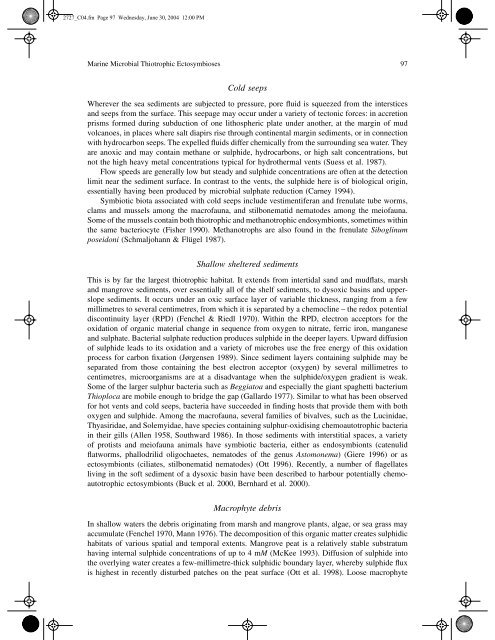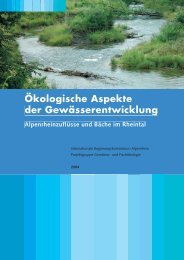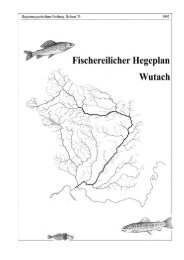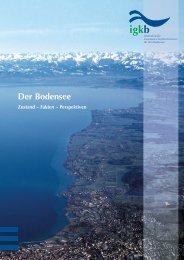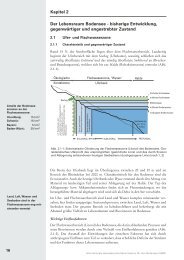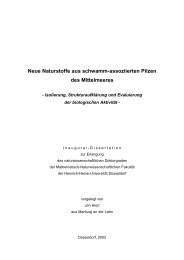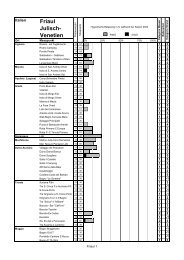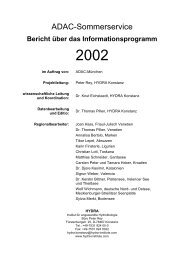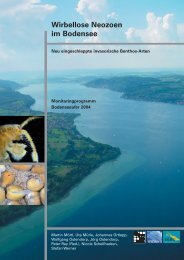marine microbial thiotrophic ectosymbioses - HYDRA-Institute
marine microbial thiotrophic ectosymbioses - HYDRA-Institute
marine microbial thiotrophic ectosymbioses - HYDRA-Institute
You also want an ePaper? Increase the reach of your titles
YUMPU automatically turns print PDFs into web optimized ePapers that Google loves.
2727_C04.fm Page 97 Wednesday, June 30, 2004 12:00 PM<br />
Marine Microbial Thiotrophic Ectosymbioses 97<br />
Cold seeps<br />
Wherever the sea sediments are subjected to pressure, pore fluid is squeezed from the interstices<br />
and seeps from the surface. This seepage may occur under a variety of tectonic forces: in accretion<br />
prisms formed during subduction of one lithospheric plate under another, at the margin of mud<br />
volcanoes, in places where salt diapirs rise through continental margin sediments, or in connection<br />
with hydrocarbon seeps. The expelled fluids differ chemically from the surrounding sea water. They<br />
are anoxic and may contain methane or sulphide, hydrocarbons, or high salt concentrations, but<br />
not the high heavy metal concentrations typical for hydrothermal vents (Suess et al. 1987).<br />
Flow speeds are generally low but steady and sulphide concentrations are often at the detection<br />
limit near the sediment surface. In contrast to the vents, the sulphide here is of biological origin,<br />
essentially having been produced by <strong>microbial</strong> sulphate reduction (Carney 1994).<br />
Symbiotic biota associated with cold seeps include vestimentiferan and frenulate tube worms,<br />
clams and mussels among the macrofauna, and stilbonematid nematodes among the meiofauna.<br />
Some of the mussels contain both <strong>thiotrophic</strong> and methanotrophic endosymbionts, sometimes within<br />
the same bacteriocyte (Fisher 1990). Methanotrophs are also found in the frenulate Siboglinum<br />
poseidoni (Schmaljohann & Flügel 1987).<br />
Shallow sheltered sediments<br />
This is by far the largest <strong>thiotrophic</strong> habitat. It extends from intertidal sand and mudflats, marsh<br />
and mangrove sediments, over essentially all of the shelf sediments, to dysoxic basins and upperslope<br />
sediments. It occurs under an oxic surface layer of variable thickness, ranging from a few<br />
millimetres to several centimetres, from which it is separated by a chemocline – the redox potential<br />
discontinuity layer (RPD) (Fenchel & Riedl 1970). Within the RPD, electron acceptors for the<br />
oxidation of organic material change in sequence from oxygen to nitrate, ferric iron, manganese<br />
and sulphate. Bacterial sulphate reduction produces sulphide in the deeper layers. Upward diffusion<br />
of sulphide leads to its oxidation and a variety of microbes use the free energy of this oxidation<br />
process for carbon fixation (Jørgensen 1989). Since sediment layers containing sulphide may be<br />
separated from those containing the best electron acceptor (oxygen) by several millimetres to<br />
centimetres, microorganisms are at a disadvantage when the sulphide/oxygen gradient is weak.<br />
Some of the larger sulphur bacteria such as Beggiatoa and especially the giant spaghetti bacterium<br />
Thioploca are mobile enough to bridge the gap (Gallardo 1977). Similar to what has been observed<br />
for hot vents and cold seeps, bacteria have succeeded in finding hosts that provide them with both<br />
oxygen and sulphide. Among the macrofauna, several families of bivalves, such as the Lucinidae,<br />
Thyasiridae, and Solemyidae, have species containing sulphur-oxidising chemoautotrophic bacteria<br />
in their gills (Allen 1958, Southward 1986). In those sediments with interstitial spaces, a variety<br />
of protists and meiofauna animals have symbiotic bacteria, either as endosymbionts (catenulid<br />
flatworms, phallodrilid oligochaetes, nematodes of the genus Astomonema)<br />
(Giere 1996) or as<br />
ectosymbionts (ciliates, stilbonematid nematodes) (Ott 1996). Recently, a number of flagellates<br />
living in the soft sediment of a dysoxic basin have been described to harbour potentially chemoautotrophic<br />
ectosymbionts (Buck et al. 2000, Bernhard et al. 2000).<br />
Macrophyte debris<br />
In shallow waters the debris originating from marsh and mangrove plants, algae, or sea grass may<br />
accumulate (Fenchel 1970, Mann 1976). The decomposition of this organic matter creates sulphidic<br />
habitats of various spatial and temporal extents. Mangrove peat is a relatively stable substratum<br />
having internal sulphide concentrations of up to 4 mM (McKee 1993). Diffusion of sulphide into<br />
the overlying water creates a few-millimetre-thick sulphidic boundary layer, whereby sulphide flux<br />
is highest in recently disturbed patches on the peat surface (Ott et al. 1998). Loose macrophyte


